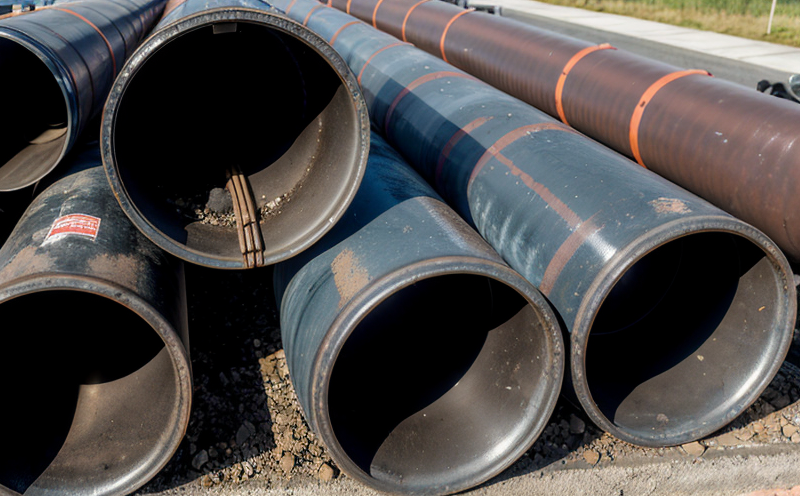ASTM D2837 Long Term Hydrostatic Strength Testing of Plastic Pipes
The ASTM D2837 standard provides a method to determine the long-term hydrostatic strength of plastic pipes. This test is critical for evaluating the durability and reliability of pipe materials under constant water pressure, which ensures their performance over extended periods without failure.
Long-term hydrostatic testing simulates real-world conditions where plastic pipes are subjected to continuous internal pressure due to the static head caused by a column of fluid. This type of stress is common in plumbing systems, irrigation networks, and industrial processes where water flows under constant pressure over an extended period.
The test involves subjecting a sample pipe section to a defined hydrostatic pressure for an extended period. The goal is to assess the material's ability to withstand this pressure without leaking or failing structurally. This testing method helps manufacturers ensure their products meet regulatory and safety standards, thereby enhancing public confidence in plumbing systems.
The ASTM D2837 standard specifies the test parameters, including temperature, pressure, and duration of exposure to hydrostatic stress. The standard also outlines the preparation of specimens, including dimensions, orientation, and any necessary conditioning before testing. This ensures that all samples are tested under uniform conditions, allowing for consistent and reliable results.
The test procedure involves placing a segment of the pipe sample in a pressure vessel where it is subjected to hydrostatic pressure. The pressure is increased gradually over time until a predetermined holding period has elapsed. During this period, the sample must not exhibit any signs of failure or leakage. After the holding period, the pressure is reduced slowly and monitored for leaks or structural damage.
The results of the test are critical in determining the suitability of plastic pipes for specific applications. For instance, in areas with high water temperatures or where there is significant static head, it's essential to select materials that can withstand these conditions without degrading over time. The ASTM D2837 test ensures that pipe manufacturers and suppliers meet this requirement.
Furthermore, the long-term hydrostatic strength testing provides valuable data for quality assurance processes and product development. By understanding how different materials perform under prolonged pressure, engineers can refine their designs to enhance durability and reduce maintenance costs. This is particularly important in critical infrastructure projects where pipe failures could have significant financial and safety implications.
The ASTM D2837 standard also plays a crucial role in regulatory compliance. Many jurisdictions require that plastic pipes used in public and private water systems pass this test before being approved for use. Compliance with this standard ensures that the pipes meet both industry best practices and government regulations, protecting consumers from potential health hazards associated with compromised plumbing systems.
In summary, ASTM D2837 long-term hydrostatic strength testing is an essential tool in ensuring the quality and safety of plastic pipes used in a wide range of applications. By following this standard, manufacturers can produce reliable products that meet regulatory requirements and enhance public confidence in their infrastructure projects.
Applied Standards
| Standard | Description |
|---|---|
| ASTM D2837-14(2019) | This standard specifies the procedure for determining the long-term hydrostatic strength of plastic pipes. It covers the test parameters, specimen preparation, and evaluation criteria. |
| ISO 15837:2016 | An international standard that provides a method for determining the long-term pressure resistance of plastic pipes used in fluid transport systems. This includes testing for both short-term and long-term hydrostatic strength. |
| EN 15794:2013 | This European standard outlines the requirements for plastic pipes used in water supply systems, including tests for long-term pressure resistance. It also covers the marking and identification of pipes. |
Industry Applications
The ASTM D2837 test is widely used in various industries where plastic pipes are critical components. These include:
- Water supply systems for residential, commercial, and industrial properties.
- Irrigation systems that require reliable pipe infrastructure to deliver water efficiently.
- Pipeline networks for transporting fluids in the oil and gas sector.
- Recycling facilities where plastic pipes are used for wastewater treatment processes.
In each of these applications, ensuring the long-term hydrostatic strength of plastic pipes is crucial. The ASTM D2837 test helps manufacturers and suppliers verify that their products can withstand the specific pressure conditions they will encounter in real-world scenarios.
The results of this testing are also valuable for quality assurance processes within companies. By regularly testing pipe samples, manufacturers can identify any potential weaknesses in their production process and make necessary adjustments to improve product quality. This proactive approach helps prevent costly failures and enhances the reputation of the company in the market.
Environmental and Sustainability Contributions
The ASTM D2837 test contributes significantly to environmental sustainability by ensuring that plastic pipes used in infrastructure projects are reliable and long-lasting. This reduces the need for frequent replacements, which can lead to significant waste generation.
Plastic pipes that meet the long-term hydrostatic strength requirements of ASTM D2837 are less likely to fail under pressure, thereby extending their useful life. This longevity translates into reduced resource consumption and lower carbon footprints associated with manufacturing new pipe materials.
Moreover, by promoting the use of durable plastic pipes, this testing method supports sustainable water management practices. Efficient water delivery systems help conserve water resources, which is a critical aspect of environmental sustainability in many regions facing water scarcity issues.
The ASTM D2837 test also aligns with broader efforts to promote circular economy principles by encouraging the reuse and recycling of plastic materials. Reliable pipes that meet long-term hydrostatic strength requirements are more likely to be recycled at the end of their useful life, reducing landfill waste and promoting a more sustainable approach to material management.





